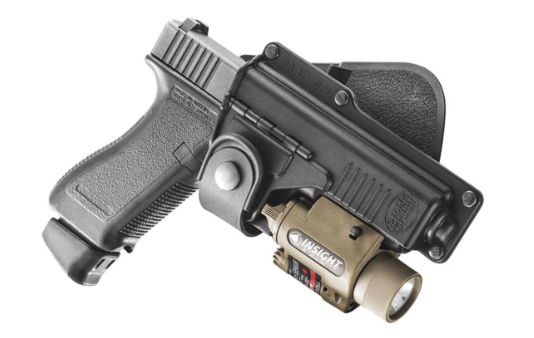When it comes to firearm safety, control, and readiness, the retention holster stands as one of the most essential pieces of equipment for law enforcement, military personnel, and responsible civilian carriers alike. Retention holsters are designed not only to secure a firearm in place but also to provide a balance between quick accessibility and protection against unauthorized use. Understanding how these retention holsters function and why they’re critical can help users make more informed decisions about their carry systems.
What Is a Retention Holster?
A retention holster is a firearm holster equipped with one or more mechanisms that hold the weapon securely in place until intentionally released by the user. Unlike simple friction-based holsters, retention holsters incorporate physical locking systems, straps, hoods, or buttons that prevent the firearm from being drawn accidentally or by someone other than the wearer.
Retention holsters are typically categorized by “retention levels.” Each level indicates the number of security mechanisms integrated into the holster. The higher the level, the more secure the firearm is — but this can also impact draw speed and ease of use.
Understanding Retention Levels
Holster retention levels are commonly divided into three main categories:
Level I Retention
A Level I retention holster typically relies on passive retention, such as friction or tension. This means the firearm is held in place by the holster’s shape or material pressure. While it offers quick access and smooth drawing, it provides minimal protection against disarming attempts.
Level II Retention
A Level II retention holster adds an active retention device such as a thumb break strap, trigger guard lock, or lever. The user must disengage this mechanism before drawing the firearm. This type is widely used by law enforcement officers because it combines a reasonable level of security with quick access under stress.
Level III Retention
A Level III retention holster includes multiple locking systems — for example, both a hood guard and a locking mechanism on the trigger guard. These holsters are designed for maximum security and are often used by uniformed officers or tactical professionals in high-risk environments.
Each level serves a specific purpose, and users should select the right balance between accessibility and security based on their needs and training.
How Retention Holsters Work
Retention holsters use a combination of mechanical locks and friction systems to hold a firearm in place. Common mechanisms include:
- Thumb Break Straps: A snap strap that goes over the back of the firearm and must be released with the thumb during the draw.
- Hood Guards or Rotating Hoods: A pivoting hood that covers the rear of the slide, requiring a specific movement to disengage.
- Push Button Locks: Found on models like the Safariland ALS (Automatic Locking System), these locks engage the trigger guard and release when a button is pressed in a precise direction.
- Friction Fit: The holster’s molding applies consistent pressure to the firearm’s frame, maintaining secure placement without additional hardware.
The effectiveness of a retention holster lies in its ability to remain secure during physical activity, struggles, or sudden movement — while still allowing the trained user to draw quickly and efficiently.
Why Retention Holsters Matter
1. Enhanced Firearm Security
The primary purpose of a retention holster is to prevent unauthorized access to the weapon. This is crucial for law enforcement officers who may face close physical confrontations, but it’s also important for civilian carriers who want to minimize accidental discharges or unauthorized access by others.
2. Improved Safety and Control
Retention holsters reduce the risk of accidental loss or discharge. The mechanisms ensure that the gun remains firmly seated, even during running, climbing, or sudden motion. For concealed carriers, this adds an extra layer of confidence and safety.
3. Professional and Tactical Use
Military and law enforcement professionals often operate in dynamic environments where physical altercations or weapon grabs are a possibility. Retention holsters provide the necessary safeguard to prevent the weapon from being taken. Many departments and agencies require officers to use holsters with at least Level II retention for duty use.
4. Balance Between Speed and Security
A well-designed retention holster allows for a quick, natural draw once the user becomes familiar with the release mechanisms. Training plays a major role here — with proper muscle memory, the retention release can be seamlessly integrated into the draw motion, preserving both safety and speed.
5. Longevity and Reliability
Quality retention holsters are constructed from durable materials such as Kydex, polymer, or reinforced leather. These materials ensure consistent performance over time, maintaining both retention strength and draw smoothness even under harsh conditions.
Choosing the Right Retention Holster
Selecting the right retention holster depends on the intended use, firearm model, and comfort preference. For example, a concealed carrier might prioritize compactness and speed with a Level I or II holster, while a uniformed officer might require the maximum security of a Level III design.
It’s important to ensure the holster is molded specifically for your firearm model, as a proper fit directly affects retention performance. Regular maintenance and practice are also essential — dirt, debris, or worn parts can compromise the mechanism.
Conclusion
A retention holster is not just an accessory; it’s a critical safety component that balances accessibility, security, and reliability. Whether for professional duty or civilian concealed carry, understanding how these holsters function helps ensure responsible firearm handling and effective protection. For those who carry specific firearm models like the 1911, investing in high-quality 1911 holsters with proper retention features can significantly enhance both safety and performance.

